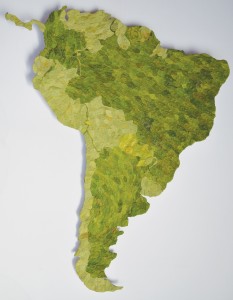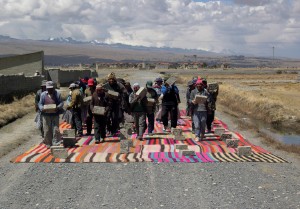« Features
Gastón Ugalde: Repositioning Rituals
By Claire Breukel
Gastón Ugalde is Bolivia’s best-known contemporary artist. Born in the city of La Paz, Ugalde is known, despite his decades long career, as the “enfant terrible” of the local art world for the subversive nature, both conceptually and materially, of his artwork. His provocative nature is grounded by an extensive and eclectic education, which includes a degree in Architecture from the Universidad Mayor de San Andrés in La Paz as well as a degree in Economics and Political Science from Simon Fraser University in British Columbia, Canada. Throughout Ugalde’s extensive career, his works span a diversity of media, including painting, photography, collage, installation and performance. He has had over 58 solo exhibitions and recently received two major honors. He was a winner of the 2002 Mercosur Konex Award, along with Brazilian architect, Oscar Niemeyer, and Uruguayan visual artist Luis Camnitzer. He was selected to represent his country in “Mundus Novus/New Worlds: Contemporary Art of Latin America” in the 53rd International Art Exhibition held at the Latin American Pavilion for the 2009 Venice Biennale. Despite Ugalde’s outspoken and controversial nature, these prestigious accolades have helped to establish him as the one of Latin America’s visual arts leaders.

Gastón Ugalde, Coca-Cola, 2010, coca leaves collage, 40” x 55.” All images are courtesy of the artist.
One of the pervading elements of Ugalde’s works is his deep affinity to his birthplace. He explains, “It is impossible to ignore the every day strong dynamic of socio-anthropological, political Bolivian way of life over the last six decades and this is reflected in the work I have produced over the last quarter century.”
To give some context, Bolivia is home to ten million people and spans a multitude of ethnicities with over 35 official languages. In response to this diversity, Ugalde’s approach to making work is one that is fearless in its attempt to depict the intangibility of one national culture. From his collage works made from coca leaves, to his installation of Andean textiles, Ugalde is able to capture and transform locally-oriented themes, that are often provocative in nature, into a universal language that pushes the envelope of art making. Specifically, Ugalde integrates references to spiritual rituals inherent to Bolivia’s culture into his discourse. ”I have come to understand that all my creativity flows twenty-four hours a day and in circles, and is deeply influenced by the Amazonian and Andean spiritual world (particularly cultural rituals with the Coca plant). I then develop these ideas in different mediums,” says Ugalde. As an artist, he also responds to his environment through the appropriation of local cultural signifiers in his work; such as through materials, which strive to encapsulate Bolivian traditions. Because of this, his use of these materials has also, at times, been viewed as controversial.
Throughout the history of Andean culture, the coca leaf has played a significant role in bringing people together, typically by being chewed or brewed into tea. Inspired by this tradition, Ugalde began experimenting with the coca plant in his work in the 1970’s. In 1992, using the dark tops and light undersides of coca leaves, Ugalde began making a portrait series depicting Latin America’s political leaders. This is particularly pertinent, as the coca leaf also happens to be the raw material from which the drug cocaine is derived and whose usage, since 1961, has been prohibited except for medical or scientific purposes (though the cultivation, sale, and possession of unprocessed coca leaf remains legal in Bolivia to this day). Using this strong political association to the material, Ugalde created a series of works depicting the U.S. dollar, the Coca Cola logo, as well as the map of the United States of America. These works are deeply ironic as the canvas, the coca leaf, is from Bolivia, a country in economic collapse that thrives on a narcotics industry largely funded by its biggest consumer, the United States of America. The U.S. dollar thus becomes a symbol of a social class in Bolivia, and in Latin America, that thrives off the production and sale of cocaine.
Ugalde further explored this notion in a coca leaf map of South America, signifying a continent in the midst of financial crisis, unified by its ability to thrive on the global market through its lucrative drug trade. By integrating materials that suggest aspects of the developing world with symbols representing the developed world, such as transnational company logos, geography, and currency, Ugalde constructs a juxtaposition that questions the ethics of a capitalist system that is often tied to narcotic commerce. These overt political constructs, his choice of materials, and the works’ accessible Pop-art overtones has gained Ugalde international notoriety.
Ugalde states, “It is important for me to cover geographic territories…transforming the landscape with minimal use of materials.” Inspired by the unique geography and visuals of the Bolivian plateaus, as well as their socio-political associations, Ugalde’s photographic series of the Salar de Uyuni salt pan is weighted in social and political context. Bolivia is home to part of the Andes mountain range, that has at its crest the world’s largest salt pan. This salt pan is one of many prehistoric lakes that, over thousands of years, has been crusted over with salt now spanning over 10,000 square kilometers. As a result, the pan is exceptionally flat and is an ideal transport route across the Bolivian plateau. This salt pan is the backdrop into which Ugalde inserts people and objects to intervene with the activities of travel and excavation. An abandoned mining train is wrapped in colorful Andean fabric, attributing to these desolate scenes fleeting aspects of humanity. The scenes become more dramatic however when Ugalde inserts people into the landscape, stripped naked, bound and strung up in postures that echo human sacrifice. Drawing on Christian iconography, in one scene a man is bound feet first to a wooden cross like an upside down crucifix, and in another, a body is crunched in a fetal position, bound and laid down on a sheet of glass as if a sacrificial lamb being offered to the Gods.
Beneath the salt layer is a brine substance that holds more than half of the world’s lithium reserves. This has been significant for Bolivia as these reserves are hugely valuable, and have been for many years in the process of being extracted. President Evo Morales, however, was resistant to the pressure of industrialized countries to extract this lithium, stating: “We will not repeat the historical experience since the 15th century: raw materials exported for the industrialization of the West that has left us poor.” The Bolivian government attempted to protect the salt pan from long-term environmental damage, while simultaneously fending off impending economic collapse that would place Bolivian people further in to poverty. Ugalde activates this socially and politically loaded territory through these human interjections. By inserting human installations into these stark and barren landscapes, depicting his subjects as dominated, disempowered and helpless, Ugalde creates a striking contrast that is a fervent commentary on the value of nature and human life against the backdrop of commerce. The awe-inspiring aesthetic of the salt pan is on the one hand otherworldly and transcendental, on the other its future is rife with uncertainty.
In 2009, Ugalde created Marcha Por La Vida/ March for Life, an installation featured at the Latin American Pavilion as part of the 53rd Venice Biennale. Expanding on his use of Bolivian cultural symbols, Marcha Por La Vida is a patchwork of traditional Inca and Aymara blankets that Ugalde had bought and collected over the years. It draws inspiration from the ritual of weaving-as both a manual act that creates a practical material for protection and warmth, as well as a spiritual act that references religious and ritualistic practices throughout history. Ugalde’s installation comprises this large connected blanket placed centrally in the space, weighted with the history of all its previous owners. Then, to transform this object Ugalde ties the blanket in a knot, specifically an Armazi knot. Through this deliberate interfering action, Ugalde halts the blankets ability to give shelter and to protect. If these connected blankets represent our shared social fabric, then the tying of the knot makes it mute. A cycle of life has ended and the blanket becomes a shroud that stores within it only memories. This knot has stopped time, perhaps implying death and perhaps the possibility of rebirth.
In his work, Ugalde engages the Bolivian landscape, as well as plants and fabrics inherent to traditions within Andean culture, and transforms them into contemporary collages, photographs and installations that speak of commerce, politics and spiritual (dis)connectedness. By combining the history and geography of his country with creative intervention and juxtaposition, he is able to pose universal questions to his audience about their connection to humanity.






































